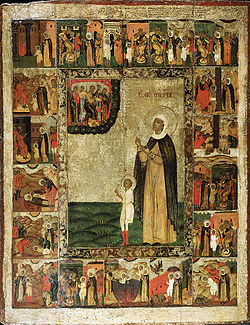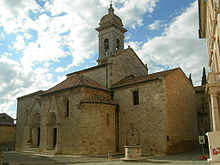- Quiricus and Julietta
-
For other uses of the name, see Cyriacus (disambiguation).
Saint Quiricus and Saint Julietta 
Died ~304 AD
Tarsus, Asia MinorHonored in Assyrian Church of the East, Roman Catholic Church, Coptic Church, Syriac Orthodox Church and Eastern Orthodox Church Major shrine Relics at Nevers, and in the monastery of Saint-Amand, Tournai. Feast June 16, July 15 (Eastern Orthodox Church) Attributes From the story involving Charlemagne, Cyricus is depicted as a naked child riding on a wild boar. Patronage Prayed to for family happiness, and the restoring to health of sick children. Saint Julietta (also known as Julitta (Greek: Ἰουλίττα)) and her son Saint Quiricus (also known as Kērykos (Greek: Κήρυκος), Cyriacus, Qyriacus, Cyricus, Ciricus and Cyr) were martyred in AD 304 in Tarsus.
Contents
Cyricus
Some evidence exists for an otherwise unknown child-martyr named Cyricus at Antioch[1]. It is believed that the legends about Saints Quiricus and Julietta refer to him. There are places named after Cyricus in Europe and the Middle East, but without the name Julietta attached. Cyricus is the Saint-Cyr found in many French toponyms. The cult of these saints was strong in France after Saint Amator, Bishop of Auxerre, brought relics back from Antioch in the 4th century. It is said that Constantine I discovered their relics originally and built near Constantinople a monastery, and not far off from Jerusalem was built a church. In the 6th century the Acts of Cyricus and Julitta were rejected in a list of apocryphal documents by the pseudo-Gelasius, called as such since the list was erroneously attributed to Pope Saint Gelasius I.
Feast day June 16
Legends
According to legend, Julietta and her three-year (sometimes described as three-month) old Cyricus had fled to Tarsus and were identified as Christians. Julietta was tortured, and her three year old son, being held by the governor of Tarsus, scratched the governor's face and was killed by being thrown down some steps. Julietta did not weep but celebrated the fact that her son had earned the crown of martyrdom. In anger, the governor then decreed that Julietta’s sides should be ripped apart with hooks, and then she was beheaded. Her body, along with that of Cyricus, was flung outside the city, on the heap of bodies belonging to criminals, but the two maids rescued the corpses of the mother and child and buried them in a nearby field.
An alternative version of the story is that Julietta told the governor that his religion could not be accepted by a three year old child, whereupon Quiricus testified to his faith, and mother and child were tortured before being decapitated.
Cyricus and Charlemagne
A story from Nevers states that one night Charlemagne dreamed he was saved from death by a wild boar during a hunt. He was saved by the appearance of a child, who had promised to save the emperor from death if he would give him clothes to cover his nakedness.
The bishop of Nevers interpreted this dream to mean that he wanted the emperor to repair the roof of the cathedral dedicated to Saint Cyricus.
Veneration
Italy
In Italy, where they are known as Quirico (or Quilico, or Chirico) and Giulitta (or Giuletta or Giulietta ),[1] the place most commonly linked with the saints is the village of San Quirico d’Orcia in the Val d’Orcia area of Tuscany. There a twelfth- or thirteenth-century church (pictured right), based on an eighth-century baptistery, is dedicated to them.[2] The cult, however, is common in many parts of country and more than 200 churches, monasteries, localities, etc with signs of devotion to one or both of the saints have been identified.[3] Other communes named after them are Corvino San Quirico (Province of Pavia), San Chirico Nuovo (Province of Potenza), San Chirico Raparo (Province of Potenza), San Quirico d’Orcia (Province of Siena), Serra San Quirico (Province of Ancona), and Santa Giuletta (Province of Pavia). Communes of whom they are patron saints include Borgo San Martino (Province of Alessandria), Cavaria in the municipality of Cavaria con Premezzo (Province of Varese), Cisternino (Province of Brindisi), Collesalvetti (Province of Livorno), and Trofarello (Province of Torino).
In parts of Piedmont, including Centallo, Asti and Murisengo, an unconnected Saint Quirico is venerated, regarded as a member of the Theban Legion.[1]
England
There are a few churches in England dedicated to Saint Quiricus and Saint Julietta, including one found at Tickenham[4] and another at Swaffham Prior, in Cambridgeshire. In Cornwall, they can be found in the villages of Luxulyan and St Veep, and there was also once a chapel at Calstock dedicated to these two saints.
Middle East
Cyriacus in particular is mentioned numerous times in the daily office of the Church of the East as attested in the large collection of prayers and services known as the Hudra. The mention of a saint from Tarsus in such East Syrian traditions suggests that there was considerable early sharing of martyrological traditions despite doctrinal differences between churches.
Footnotes
- ^ a b Santi Quirico e Giullita : I lori nomi (Italian)
- ^ For a description and history of the church see Collegiata dei Santi Quirico e Giulitta (English)
- ^ See the list at Santi Quirico e Giullita: Il culto in Italia.
- ^ http://www.tickenhamchurch.org.uk/
External links
- "St. Julitta, Martyr", Butler's Lives of the Saints
- Catholic Encyclopedia
- Saint Julitta
- Church of St Quiricus and St Julietta, Tickenham, England
- Cyriac Family History Project - Saints Cyr & Julitta page
- Orthodox Church of America
- St. Cyricus page at Christian Iconography
- "Saint Quiricus and His Mother Saint Julitta" from the Golden Legend
Categories:- Persian saints
- Persian Roman Catholic saints
- Christian martyrs of the Roman era
- Eastern Orthodox saints
- 304 deaths
- Saints duos
- Child saints
- Saints of the Golden Legend
- 4th-century Christian martyr saints
- 4th-century Romans
- 4th-century Christian female saints
Wikimedia Foundation. 2010.


